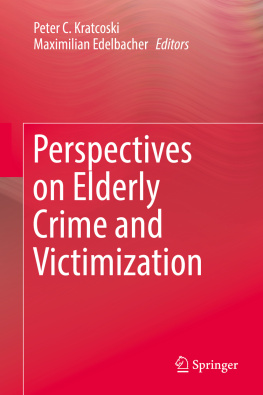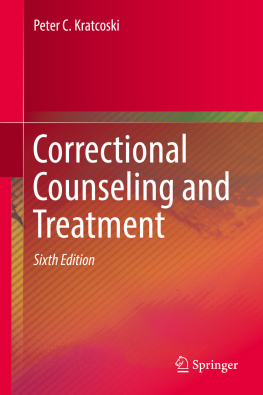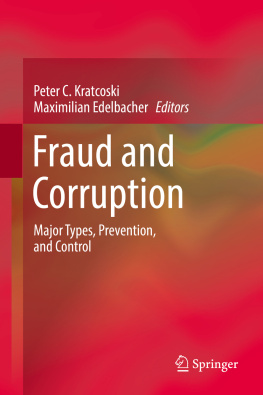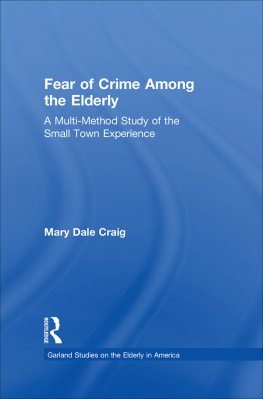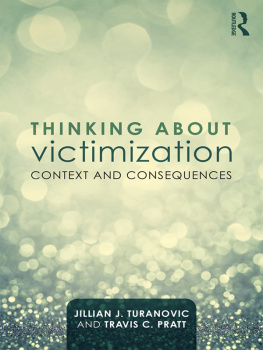Peter C. Kratcoski - Perspectives on Elderly Crime and Victimization
Here you can read online Peter C. Kratcoski - Perspectives on Elderly Crime and Victimization full text of the book (entire story) in english for free. Download pdf and epub, get meaning, cover and reviews about this ebook. year: 2018, publisher: Springer International Publishing, genre: Home and family. Description of the work, (preface) as well as reviews are available. Best literature library LitArk.com created for fans of good reading and offers a wide selection of genres:
Romance novel
Science fiction
Adventure
Detective
Science
History
Home and family
Prose
Art
Politics
Computer
Non-fiction
Religion
Business
Children
Humor
Choose a favorite category and find really read worthwhile books. Enjoy immersion in the world of imagination, feel the emotions of the characters or learn something new for yourself, make an fascinating discovery.
- Book:Perspectives on Elderly Crime and Victimization
- Author:
- Publisher:Springer International Publishing
- Genre:
- Year:2018
- Rating:5 / 5
- Favourites:Add to favourites
- Your mark:
- 100
- 1
- 2
- 3
- 4
- 5
Perspectives on Elderly Crime and Victimization: summary, description and annotation
We offer to read an annotation, description, summary or preface (depends on what the author of the book "Perspectives on Elderly Crime and Victimization" wrote himself). If you haven't found the necessary information about the book — write in the comments, we will try to find it.
Perspectives on Elderly Crime and Victimization — read online for free the complete book (whole text) full work
Below is the text of the book, divided by pages. System saving the place of the last page read, allows you to conveniently read the book "Perspectives on Elderly Crime and Victimization" online for free, without having to search again every time where you left off. Put a bookmark, and you can go to the page where you finished reading at any time.
Font size:
Interval:
Bookmark:


This Springer imprint is published by the registered company Springer International Publishing AG part of Springer Nature.
The registered company address is: Gewerbestrasse 11, 6330 Cham, Switzerland
This book is dedicated to elderly men and women throughout the world
The populations of nations throughout the world, especially those economically developed countries of North America, Europe, and Asia, have become older.
In the United States and Europe, the baby boomer generation born soon after World War II ended is now approaching senior citizen status. Later generations of child-bearers in various countries, either by choice or by adherence to government policies, had fewer children than families in the past generations. At the present time, many countries are seeing a population decline and a change in the structure of the population, with a larger segment of the population in the older age category.
This change has not gone unnoticed by the shakers and doers in the industry, retail marketing, and the housing market, as well as political leaders. For example, in the past, housing, clothing styles, and recreational and leisure time operations were geared toward the younger and middle-aged populations. Now, there has been a dramatic shift in focus toward older persons who have the time, funds, and resources for housing, clothing, and activities consistent with an older age lifestyle.
There has also been a gradual trend in the interests of criminologists to study the causes of elderly crime and elderly victimization by crime, as well as criminal justice practitioners who respond to elderly crime and elderly victims of crime.
The chapters in this book were written by criminologists who have completed research on the causes of elderly crime and the response of the justice system to those older offenders convicted of a criminal act and criminal justice practitioners who have dealt with many criminal cases involving the elderly during their careers. The authors of the chapters focus on the criminal behavior of the elderly and provide valuable information on the causes of elderly crime, the scope of the problem, and the ways the criminal justice systems of their countries respond to older offenders.
In regard to the older offender, it is often stated that human nature is the same and does not change, regardless of the country in which the human behavior is manifested. According to this view, if a person has the disposition to engage in behavior defined as deviant or criminal as a young person, the deviant behavior will continue as an adult and even into an old age. This will be true, regardless of the specific social, economic, and cultural situation of the person. This notion is challenged by authors in the various chapters of this book who demonstrate that elderly crime is related to the specific social, personal, and economic situation of the individual as well as the social and political situation of the country and times in which the elderly person lives.
There are many similarities in the characteristics of the older offenders who reside in the various countries represented in this book. These include the types of crimes committed, the motivation for committing the crimes, and the opportunities for the older persons to commit crimes. There are also differences that are predominately related to the cultures of the countries, the nature of the acts that are defined as violations of the criminal law, and the opportunities for the elderly to commit crimes.
A portion of this book focuses on the victimization of the elderly. The increase in the number of elderly persons, as well as the changes in the lifestyles of the elderly, has led to increases in the amount of criminal victimization of the elderly. Other factors that help to explain why the elderly are vulnerable for victimization pertain to changes in the structure of the family as well as changes in the types of activities and social relationships of the older population. Several authors in the book attribute the decline of the extended family, the physical and social isolation of the elderly, and the increase in dependence of the elderly on caretakers who are not related to them as factors that relate to the criminal victimization of the elderly.
When the offender-victim relationship is analyzed by authors reporting on different countries, several similarities in the relationship for both violent crimes and property crimes appear. In a large proportion of the crimes against persons such as murder, domestic violence, and assault, the offenders and victims are intimately related, relatives, or acquaintances. In the case of most property crimes, with the exception of theft, the offender is more likely to be a stranger to the victim.
Older persons living alone and without a network of friends or service agencies to rely on to provide advice or to assist in times of trouble are most vulnerable to victimization through scams and frauds of various types. If older persons have one or more disabilities, such as a physical handicaps or mental deterioration, and do not have family, friends, or community agencies to provide assistance, they become easy targets for criminals.
The governments of many of the countries have recognized the problem of the crime and victimization of the elderly and taken steps to address these problems through legislation and by providing funds for victim assistance programs.
The chapters in this book demonstrate that criminal victimization of the elderly is a complex problem and the issue needs more research. Their contributions are a beginning.
Font size:
Interval:
Bookmark:
Similar books «Perspectives on Elderly Crime and Victimization»
Look at similar books to Perspectives on Elderly Crime and Victimization. We have selected literature similar in name and meaning in the hope of providing readers with more options to find new, interesting, not yet read works.
Discussion, reviews of the book Perspectives on Elderly Crime and Victimization and just readers' own opinions. Leave your comments, write what you think about the work, its meaning or the main characters. Specify what exactly you liked and what you didn't like, and why you think so.

